CRU aluminum: Trade continues to be hot topic
The Mexican federal government backed down on the application of tariffs on raw non-alloyed and alloyed aluminum decreed on April 22.
The Mexican federal government backed down on the application of tariffs on raw non-alloyed and alloyed aluminum decreed on April 22.
Steel Market Update’s Steel Demand Index fell eight points, and back into contraction territory, an indication demand might be slipping as prices have trended lower, according to our latest survey data.
The latest SMU market survey results are now available on our website to all premium members. After logging in at steelmarketupdate.com, visit the pricing and analysis tab and look under the “survey results” section for “latest survey results.” Historical survey results are also available under that selection. If you need help accessing the survey results, or if […]
Stelco reported a positive start to 2024 in its first-quarter earnings report on Thursday. And with steady demand and a stable market, the Canadian flat-rolled steelmaker is optimistic for the remainder of the year.
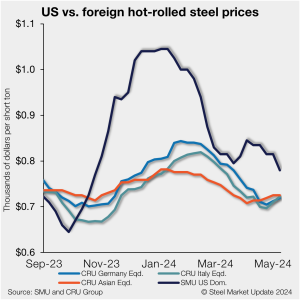
US hot-rolled (HR) coil prices declined again, tightening their premium over offshore hot band, and moving closer to parity.

Hot rolled, cold rolled, and plate buyers said mills are more willing to talk price on spot orders this week, while the overall negotiation rate for products SMU surveys remained level, according to our most recent survey data.
Most steel products tracked by SMU saw lead times contract this week from two weeks earlier, according to SMU’s most recent survey data.
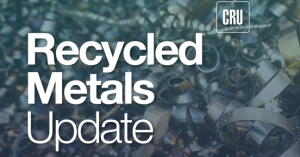
After a considerable wait, the market for ferrous scrap for May shipment has started to form.
Unless you've been under a rock, you know by know that Nucor's published HR price for this week is $760 per short ton, down $65/st from the company’s $825/st a week ago. I could use more colorful words. But I think it’s safe to say that most of the market was not expecting this. For starters, US sheet mills never announce price decreases. (OK, not never. It has come to my attention that Severstal North America rescinded a price increase back on Feb. 14, 2012. And it caused quite the ruckus.)

Sheet prices fell across the board this week – largely in response to Nucor’s $65-per-short-ton price cut for hot-rolled (HR) coil on Monday morning. SMU’s HR coil price is $780/st on average, a $35/st decrease week over week (w/w). Our average cold-rolled coil price is $1,090/st (down $30/st w/w). Our galvanized base price is $1,100/st […]

When we were asked to provide some additional commentary to SMU about the futures markets for flat rolled, our only reluctance to contribute was rooted merely in the fact that SMU (1) already offers an excellent array of authors on this topic and (2) a concern regarding what new ground could be covered that hasn’t already been discussed to death on this issue. Thankfully, however, Nucor has offered up something we can describe, without hyperbole, as simply revolutionary for spot pricing in flat rolled - a development that we simply could not resist commenting on with respect to its probable impacts on the futures market.
Nucor started off May with a bang, dropping its weekly base spot price for hot-rolled (HR) coil by $65 per short ton (st) this week.
Is it just me, or does it seem like the summer doldrums might have arrived a little early? I could be wrong there. It’s possible we could see a jump in prices should buyers need to step back into the market to restock. I’ll be curious to see what service center inventories are when we update those figures on May 15. In the meantime, just about everyone we survey thinks HR prices have peaked or soon will. (See slide 17 in the April 26 survey.) Lead times have flattened out. And some of you tell me that you’re starting to see signs of them pulling back. (We’ll know more when we update our lead time data on Thursday.)
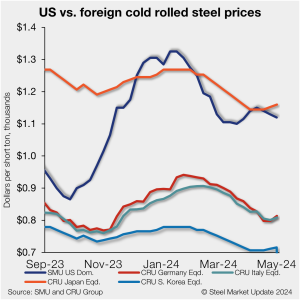
Foreign cold-rolled (CR) coil remains much less expensive than domestic product even as domestic prices continue to decline, according to SMU’s latest check of the market.
Olympic Steel logged lower earnings in the first quarter of 2024, but the company said all three of its segments contributed to profitability.

As we approach “buy week,” a term industry veterans use to refer to steel mill scrap buying time and an excuse to remain in the office, we have seen a variety of slants on the May market.
Everybody has a plan… until they’ve dealt with volatility in the HRC market. While Mike Tyson’s original quote was about getting punched in the mouth, it’s unlikely the ex-champ has gone many pricing rounds with hot-rolled coil.
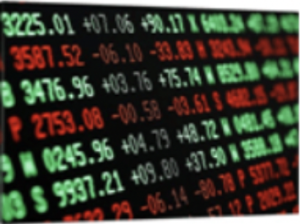
“One thing we know for certain, however, is that when we write our next column, things will have certainly shaken loose.” – Daniel Doderer, April 4, 2024. Above is a good reminder that whenever someone is “certain” of anything, you should probably look at that line of thinking with a healthy dose of skepticism.
ArcelorMittal posted a narrower Q1’24 profit compared to Q1’23 but remained optimistic about steel's long-term demand prospects.
Russel Metals’ earnings fell in the first quarter, but the Toronto-based metals distributor sees steel prices stabilizing in the near term and staying above historical averages.
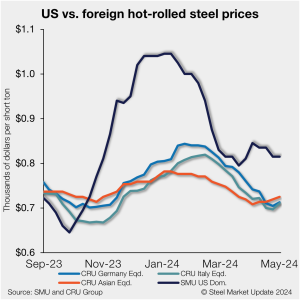
US hot-rolled (HR) coil price premium over offshore hot band has tightened on the back of lower domestic tags, though stateside HR coil remains markedly more expensive than imports.

On Monday and Tuesday of this week, SMU polled steel buyers on an array of topics, ranging from market prices, demand, and inventories to imports and evolving market chatter.

Sheet prices were flat or moderately down again this week – underscoring the shift in momentum we’ve seen over the last month. The exception was hot-rolled (HR) coil, which was largely unchanged from last week.
Nucor Corp. announced that its plate mill group would cut prices for as-rolled, discrete, and normalized plate with the opening of its June order book. The Charlotte, N.C.-based steelmaker said in a letter to customers on Monday, April 29, that tags would be lowered by $90 per short ton (st). That would bring its base price to roughly $1,200/st.
What a difference a month makes. In late March, it seemed like the US hot-rolled (HR) coil market was poised to cycle upward. Large buyers had re-entered the market and placed big orders earlier in the month. Several outages were underway or upcoming. And expectations were that lead times would continue to extend. Cliffs said […]
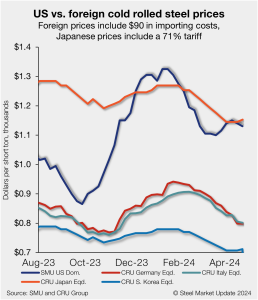
Foreign cold-rolled (CR) coil remains much less expensive than domestic product, according to SMU’s latest check of the market.
The latest SMU market survey results are now available on our website to all premium members. After logging in at steelmarketupdate.com, visit the pricing and analysis tab and look under the “survey results” section for “latest survey results.” Historical survey results are also available under that selection. If you need help accessing the survey results, or if […]

SMU’s Steel Buyers’ Sentiment Indices both rose this week to reach some of the highest levels seen this year.
GrafTech is reporting weak near-term demand for graphite electrodes as economic uncertainty constrains steel production globally.
Cleveland-Cliffs said its base spot hot-rolled (HR) coil price will be $850 per short ton (st) with the opening of its June order book. The company made the announcement in a press release and in a letter to customers on Friday.